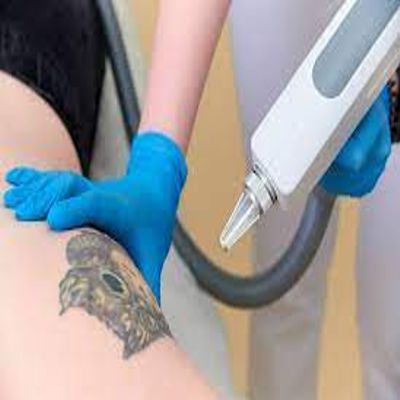Tattoo removal has become increasingly popular, with advancements in laser technology making the process more accessible and effective. However, the success of tattoo removal depends heavily on the ink colors used in the tattoo. Different colors respond differently to laser treatments, and understanding these nuances is essential for anyone considering tattoo removal. In this article, we'll explore the various tattoo ink colors and the challenges associated with their removal, especially with Laser Tattoo Removal in Muscat.

The Basics of Tattoo Ink and Laser Removal
Tattoo ink is composed of pigments that are embedded into the skin's dermal layer. These pigments vary in composition, size, and color, affecting how they interact with laser light. During laser tattoo removal, the laser emits light at specific wavelengths to target the ink particles. The laser's energy breaks down the ink into smaller particles, which are then naturally eliminated by the body. However, not all colors respond equally to laser treatment, leading to varying levels of difficulty in removal.
The Challenge of Black Ink Removal
Laser Tattoo Removal in Muscat
Black ink is the most common and typically the easiest color to remove with lasers. This is because black ink absorbs all wavelengths of light, allowing the laser to effectively break down the pigment. Laser Tattoo Removal in Muscat is particularly effective for black ink tattoos, often requiring fewer sessions compared to other colors. However, the depth of the ink and the density of the pigment can still impact the removal process.
Removing Red and Pink Inks: Unique Challenges
Red and pink inks are popular in many tattoos, but they present specific challenges during laser removal. These colors are often more resistant to laser treatment because they absorb only certain wavelengths of light. Laser Tattoo Removal in Muscat typically uses lasers that emit green light (532 nm) to target red and pink inks, but multiple sessions may be necessary to achieve complete removal. Additionally, certain red pigments may cause allergic reactions when exposed to laser energy, complicating the removal process.
The Difficulty of Blue and Green Inks
Blue and green inks are notoriously difficult to remove, often requiring more advanced laser technology. These colors are resistant to the wavelengths used in traditional laser treatments, necessitating the use of lasers with longer wavelengths, such as the
Nd laser at 755 nm. Laser Tattoo Removal in Muscat may require specialized equipment to effectively target blue and green inks, and patients should be prepared for a longer treatment process.Yellow, Orange, and White Inks: The Most Stubborn Colors Yellow, orange, and white inks are among the most challenging to remove.
These colors reflect most of the light, making it difficult for the laser to break down the pigment. Laser Tattoo Removal in Muscat often requires a combination of different laser wavelengths to address these colors, and even then, complete removal may not be possible. Yellow and orange inks are particularly resistant to treatment, while white ink can sometimes darken when exposed to laser energy, creating additional challenges.
Factors Influencing Tattoo Removal Success
Several factors influence the success of tattoo removal beyond just the ink color. These include the age of the tattoo, the depth of the ink in the skin, the type of ink used, and the patient's skin type. Laser Tattoo Removal in Muscat takes these factors into account when developing a treatment plan. Older tattoos are generally easier to remove as the ink has naturally faded over time. However, newer tattoos with vibrant colors may require more sessions to achieve desired results.
Advanced Techniques in Laser Tattoo Removal
To address the challenges of removing certain ink colors, advanced laser technologies have been developed. Laser Tattoo Removal in Muscat may utilize picosecond lasers, which deliver energy in shorter bursts than traditional nanosecond lasers. This allows for more precise targeting of stubborn ink colors and reduces the risk of skin damage. Additionally, multi-wavelength lasers can be used to treat tattoos with multiple colors, improving the overall effectiveness of the removal process.
The Importance of Professional Consultation
Before undergoing laser tattoo removal, it's crucial to consult with a professional who can assess the specific characteristics of your tattoo and skin. Laser Tattoo Removal in Muscat offers consultations to determine the best course of treatment based on factors like ink color, tattoo size, and skin type. A tailored approach ensures that you receive the most effective treatment with the least risk of complications.
Aftercare and Recovery Post-Laser Tattoo Removal
Proper aftercare is essential to ensure the success of laser tattoo removal and minimize the risk of scarring or infection. Laser Tattoo Removal in Muscat provides detailed aftercare instructions, including keeping the treated area clean, avoiding sun exposure, and applying recommended ointments. Following these guidelines can significantly improve the outcome of your tattoo removal and promote faster healing.
Conclusion: Understanding Tattoo Ink Colors and Their Removal Challenges
Tattoo removal is a complex process influenced by various factors, with ink color being one of the most significant. While black ink is generally easier to remove, colors like red, blue, green, yellow, and white present unique challenges that require specialized treatment. Laser Tattoo Removal in Muscat offers advanced technologies and expert care to address these challenges, ensuring the best possible results for each patient.
